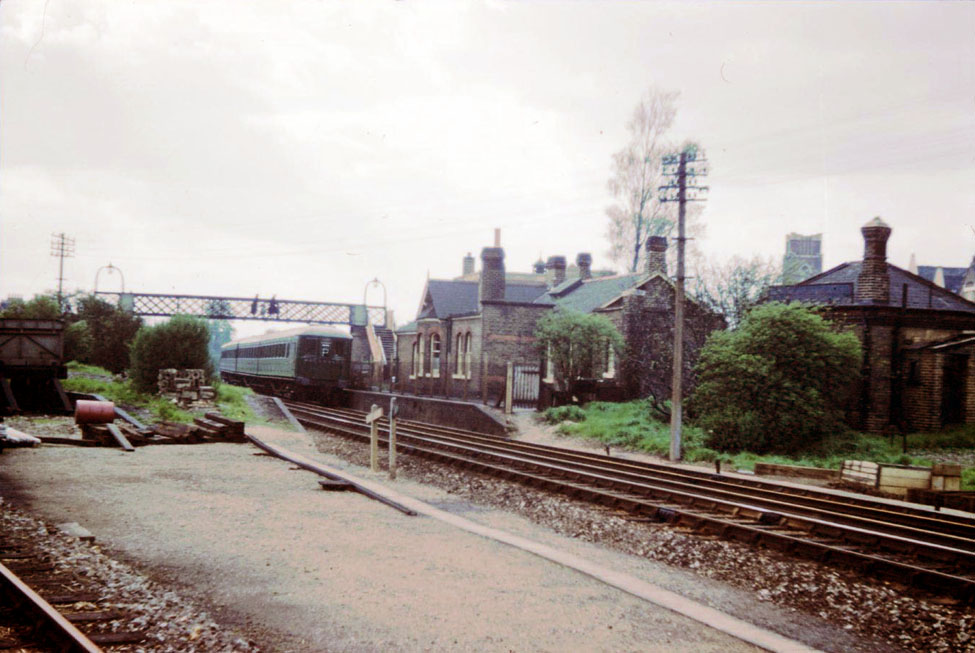
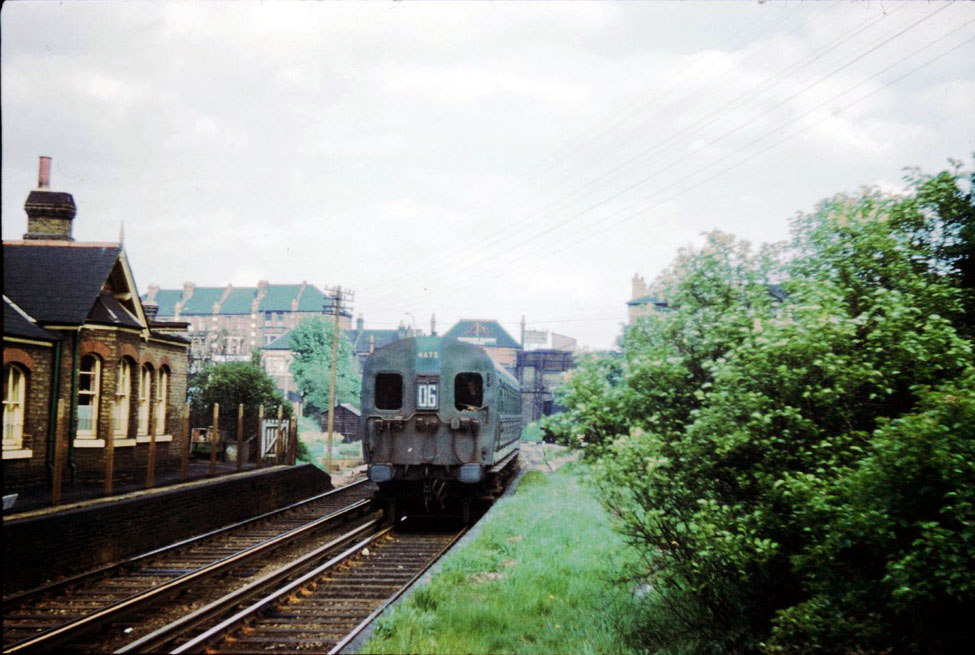
Electric Trains through Tooting Station c1959
 |
| Click on picture [232b] for an enlarged version |
 |
| Click on picture [233b] for an enlarged version |
Notes by David Bradley
These pictures were taken by me in February 1959, but 40 years later the pictures have deteriorated
requiring some restoration attention with PaintShop Pro.
The station buildings have survived into the 21st century but will be demolished in 2003 to make way for some housing.
Some would like to see the buildings listed and being used for alternative purposes but little local interest and apathy
will see this historically interesting station being lost for ever.
Some thoughts on this matter by visitors to this site are shown below.
From: "Bill Hayles"
The location is Tooting with the disused Merton Abbey branch platform on the left.
Picture 232b shows a pre-war 3SUB, augmented to 4SUB with a trailer coach from a former trailer set. The unit number is
uncertain but is probably one of a batch built for the Eastern Section electrification programme, and would date from
about 1926. It would be at the very end of its working life.
In picture 233b we see a post-war Bulleid design 4SUB unit 4675, built in 1949 and scrapped in 1982.
Benitachell, Alicante, Spain
From: "Geoff Bannister" <gbannister10@gmail.com>
The pictures are of great interest to me because when I first came to London, I lived with my parents
at 90b Longley Road which backed onto the railway about 200 yards from where these photos are taken. The old Merton
Abbey branch track survived at the Merton end to service the Triang factory etc. until the firm moved during the 1970s
and the remains of the line at that end were then incorporated into the line of the Merton relief road [Merantun Way]
in 1989. I was teaching in Morden from 1961-93 and used the road from South Wimbledon to Morden almost every day.
Looking at the 4SUB photo, this is of particular interest because it is indeed an SECR pattern motor car and appears to
have been augmented with a similar trailer. Most augmentation was carried out using Bulleid all-steel trailers and there
were very few SECR pattern units augmented in this way, most of the units handled like this being ex-LBSC.
From: "The Late Chris 'fufas' Grace"
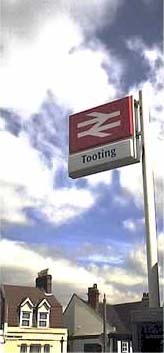 |
Trains from Tooting go direct to: Wimbledon [8 minutes], London Bridge [22 minutes] and Luton Airport [78 minutes] |
I think I should correct what one of your correspondents has written about Tooting Junction station.
It wasn't a junction in 1959, and I don't think it had been a junction since the 1920s. The Merton Abbey branch [which
has now been covered by a road] did indeed continue to the Tooting station yard but terminated at buffer stops about
20 yards from the direct line to Wimbledon. The line was served from the Merton Park end. I used to cross it many times
where it ran next to the Lines Bros Triang factory and I never saw a train on it and as far as I can remember the lines
were always rusty, however the Middleton Press book "Rails around Wimbledon" shows a page from a 1950s working
timetable showing that it was still in use. The book has a picture of Tooting yard showing the aforementioned buffer
stops. I'm pretty sure that the station was simply called "Tooting" at that time although it was still
known locally as "Tooting Junction".
I went to Rutlish school which was originally next to the Merton Park junction, although the school had moved by the
time I went there, and our Geography Master drew a rail map showing the junction still in place in 1959, causing much
merriment in the class. But his map also showed the junction at Waterloo between the L&SWR and SER which had been gone
for 60 years or so at that time, giving rise to speculation as to whether he knew whether Mafeking had been relieved!
From: "Richard Jennings"
Well done, David. They brought back happy memories of travelling to school on those 4-SUBs!
But was this station worth preserving? Frankly I don't think so, and I write as someone who is pleased to live in a
house only a few years younger.
From a railway point of view, the building seems very close to the track, making the up platform extremely narrow, and
its position in a side street on one side of the tracks is much less convenient than the new station accessed from the
bridge on the main road.
From an architectural point of view, a pitched roof at right angles to the tracks has been erected which partially
covers the bay roof by the platform in a very inelegant manner, a real bodge!
It's old, but let's face it, its design quality and fitness for purpose were poor. Sorry Ben - perhaps you should
suggest another [undemolished!] station that should be listed.
From: "Ben Nunn" <bennunn@depro.co.uk>
The width of the up platform was hardly relevant as passenger trains ceased to call there 109 years
ago!
The fact that there is any platform left on the site after all this time is a miracle in itself. And in the 1980s made
an interesting garden feature for the residents. I struggle to think of any other unpreserved station sites in the country
that closed in the 19th century, and still have platforms remaining.
Indeed the site was far too cramped to accommodate traffic from the main line and the Merton Branch and this is actually
why it was replaced by the present station in 1894.
*All* of them should be listed, simply for being disused stations. Every time I travel down City Road, I worry that the
building might be gone. As an aside, I know there's nothing I can do to stop the destruction of Wood Lane - unique as it
is - and this will probably be another one when I walk down the road and notice it conspicuous by it's absence.
And thereafter walking down the road will never be the same again.
From: "Ian Smith" <ian.d3.smith@bt.com>
This time I can add nothing about the trolleybus pictures, but as for the rather nice railway views a
few memories stir.
During the late 60's early 70's I attended Pelham school in Southey Road, Merton Park and was a frequent, if reluctant
visitor to the school playing fields in the 'V' between the Wimbledon - West Croydon line [the Wooden Bullet, or the '2'
line], and the Merton Park - Merton Abbey - Tooting line. Here one could observe the coming and goings on the Merton
Abbey branch. During the late sixties there was a morning freight from Wimbledon Yard to the Merton Abbey branch, an
afternoon freight trip and very occasionally a third freight if required. Certainly in latter days trips beyond
Merton Abbey to Tooting grew less and less frequent until they expired altogether around 1968, the tracks being lifted
around 1970. Despite visits to the footbridge at Tooting no activity was ever observed, just the odd wagon lurking in a
dark corner. The run round loop for the yard went right up to the road bridge at Tooting, and for a long time housed a
departmental van, but the actual connection to the 'main line' was removed by the nineteen thirties.
As mentioned in another memory there was the Lines Brothers factory which was rail connected for a time in the 50'and
60's, and they used their own 'BD' containers liveried and branded for the various parts of the Triang empire. This
connection had been disused and lifted before final closure. There was also a private connection to the Merton Board
Mills at Merton Abbey station, though when this was finally taken out of use is not at all clear, certainly the siding
connections where still in situ in 1969/70. The Merton Abbey branch finally closed around 1979, the remaining coal traffic
having become rather sparse in latter days. True to form BR had manufactured a new scissors crossing at Redbridge for
the Merton Park junction, but the branch closed before it could actually be fitted. [Oddly exactly the same happened
on Ryde Pier, except but the signal box there began collapsing into the sea instead!, that point work finishing up at
Sheffield park on the Bluebell, but I digress!]
Latterly motive power for the branch was the occasional class 03/04 but mainly class 08 shunters, and then the inevitable
class 73. The traffic was mainly worked via Wimbledon and Norwood as the line was considered to be LBSCR rather than
via Feltham which was LSWR.
From: "Alan Pearmain"
My late mother used to travel by train from Merton Abbey to her school in Wimbledon. She lived in
the old school house near the corner of Fortescue Road, where my grandfather was the caretaker.
Talking of Merton Abbey and preservation etc, there was an original archway from the Abbey - one of the very few
remaining pieces of the structure - which was deteriorating, so Merton Council carefully dismantled this ancient
monument for preservation. When they came to look for it - oh, dear. The numbered stones had apparently been used
for hardcore. [Or, one suspects, sold to a local garden centre...]
From: "Geoff Bannister" <gbannister10@gmail.com>
If I may disagree with Chris Cook, the junction at Tooting was taken out - I think at the time of the
electrification of the Wimbledon-Streatham line in 1929. The line was worked as a dead end from Merton Park. As I have
commented elsewhere, it was in use certainly serving the Triang works until at least the mid-1970s and Merantun Way was
then built along its alignment in 1989 between Morden Road and Christchurch Road.
It had been planned to extend the new road further towards Merton Park but it ran into heavy opposition from local
residents.
From: "Peter Wright"
In picture 232b, a church tower is visible above the station out-buildings. This was Tooting Junction
Baptist Church. This 1930's building was structurally unsafe and demolished about 1977, when the church 'moved' into
its halls complex which is [was?] directly behind the old station building and parallel to the line. The Graveney
re-emerges into daylight from under the far west end of the church halls.
The station was never officially named Tooting Junction. The 'junction' name appears to arise from local usage. Even
in the 60's, bus destination blinds read 'Tooting Station' with explanatory small type: 'Southern Region'.
It is difficult to envisage that much land would be realised by demolishing the old station building, since it sits
comfortably between the line and a public footpath. Of course, things may have changed since I was last there in 1976.
I used to go to Rutlish School by bus. Any bus to Mitcham 'Fair Green' and then the 152 to Merton/Wimbledon Chase.
When the 152 was converted to one-man-operation [yawn - are we there yet], I found it only took 10 minutes longer to
walk to school [and I pocketed the bus fare too!]. I used to walk along the Merton Abbey line from the level crossing
on Swains Lane which had been locked in favour of the abandoned railway line, coming off just before Merton Park
Station [where you could hope and hope that the short (two-car) '2' train would stall on the long dead spot of the
level crossing, but it never did].
From: "Roger" <romic@cix.compulink.co.uk>
That was probably the associated platforms / buildings and disused track that went to Merton Abbey
Mills - it branched off at this point. The main station entrance building was that which was still left until
recently.
It is only fairly recently[ish] that the old track area has been developed. The bridge over the track at London Road
was demolished and the road levelled, Merantun way was built on the site of the track at the South Wimbledon end and the
area of the track towards Tooting station had houses built over it. I assume that most of the work that went on
happened at around the same time - i.e. when BR sold off the land.
When I first remember seeing the site of the old Tooting station, it was a builders merchants. I don't know if it became
that after the demolition. Recently the builders merchants disappeared and the area lay derelict other than the
installation of a mobile phone mast. I haven't been there for a while, but assume that the whole area is now being
redeveloped.
From: "The Late Chris 'fufas' Grace"
I have just re-read this page with all the comments. Interestingly out of the people posting comments,
two went to Rutlish School and one to Pelham School. Pelham took over the old Rutlish School buildings and sports ground
which were next to Merton Park station when Rutlish moved to Watery Lane. Small world, ain't it?
Also having found my copy of "Lines Around Wimbledon" I can confirm the following about Tooting:
From: "Ian Smith" <ian.d3.smith@bt.com>
Dateline: July 2003. The original station buildings have now finally been demolished and have been
replaced with what appear to be small office units, apartments, or a combination of both even. However the remains of the
platform edging is still in situ.
The footbridge is still in place serving a footpath. The small goods shed opposite the original station site has also been
demolished within the last week, its last role had been as a 'Brick Showroom' within a builders supply yard complex, the
whole goods site is now being cleared, for one supposes the inevitable housing site.
From: "John Fitzgerald" <Fjofitz@aol.com>
I was born in Abbey Road just before the war, in the 1940's we used to hang around the Merton Abbey
Station and watch the shunting of the coal trucks on a few occasion we had the luck to be invited on the footplate
and on at least two occasion we rode down to Merton Park station and back. This would not be allowed today on health
and safety and it's such a shame that my grandchildren will not experience such a thrill.
To my knowledge the station house was occupied up to about 1958, during the war I was told [I do not remember] there
was a mobile anti aircraft gun operated on this stretch of track.
In Nelson Grove Road their was an Italian prisoner of was camp, I remember the prisoners working on the land next to
the track, this was Liberty's sports field which is now covered by a factory estate.
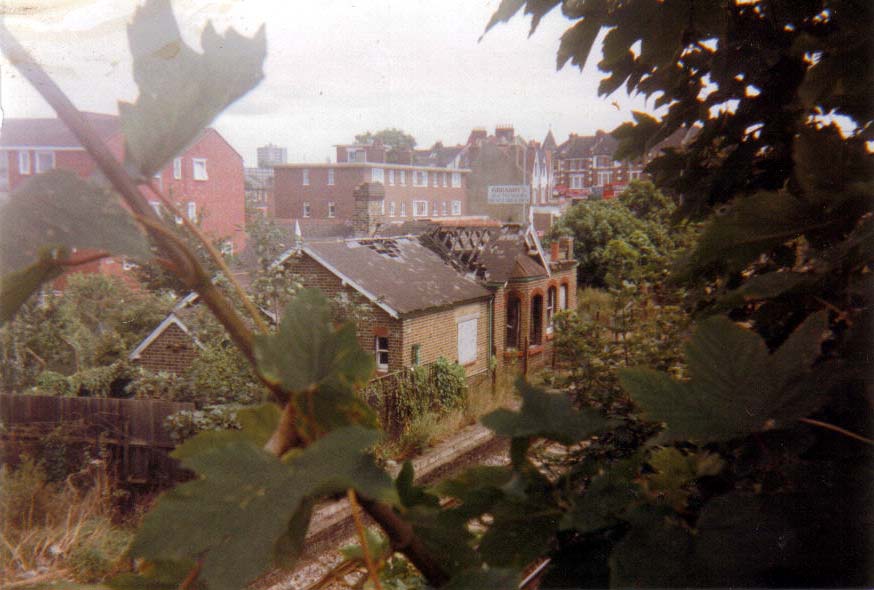 |
| Click on picture [232c] for an enlarged version |
From: "Charlie Pottins" <CharlesPottins@aol.com>
My picture [232c] is of the old station buildings at Tooting, taken I think from the SW, some time in the 1980s. Sorry it was a bit hazy [like my memory]!
From: "Ian Baker" <ib004i0234@blueyonder.co.uk>
I greatly enjoy your Southern Electric and Trolleybus items on the net, having lived at Tooting
from 1949 to 1975 and remember it well.
I actually set foot in the old buildings a number of times as I was friendly with the family of the SM at Tooting
[post 1894 station] going to school with their son and often went for tea there as they lived in the old premises!
Can I have further clarification regarding the demolition of the original Tooting Junction buildings
[Ian Smith e-mail?] last year [2003] as I frequently write for the "London Railway Record" and such
information is vital!
Although I was a little young to photograph trolleybuses in South London I do have many RT/RM/DMS type shots I took.
I also shot various rail tours and freight on the Merton Abbey branch between 1965 and 1974 plus many London railway
shots from 1963 to the present day should they be of interest to anyone.
From: "Helena Wojtczak"
I lived right by Tooting Station at London Rd, and was a guard at Wimbledon
Park for 10 years.
I liked your site - mine is at: www.railwaywomen.co.uk
From: "Lynne Mendoza" <lynne@mendozas.co.uk>
Dateline: July 2004. I've just enjoyed reading through this page on the old Tooting station.
I live on Longley Road on the opposite side to the railway track. The builders merchants that was demolished is now
Lidl Supermarket with the biggest car park you ever did see! The old station building was demolished to build an ugly
house like structure a few years back. That in turn was demolished [2003?] and two blocks of not unattractive flats
have taken their place. The beautiful railway house with its decorative features is still there though.
Cheers and thanks for the interesting read.
[I'm a parent governor at Sellincourt School and also run the PTA there too. Sellincourt School will be officially 100
years old in 2007 [the permanent buildings were erected in 1907] and I'm hoping to produce a nice
[glossy] book of the history of the school to coincide with this. I'm aware that it first began in 1904 and was known
as the Tin School [it was just a corrugated metal hut]. I have a fair amount of info to be going on with, but I shall
be contacting those on your web pages who mention connections with the school too. If you would like to provide
additional information on the School, please make contact].
PS. I found these two photos on the 2tin website to illustrate the route to walk from the Mitre to Deen City Farm and Morden
Hall Park. They show that I was wrong about the station buildings being demolished to erect the "ugly house" -
they were still there at that time and so must only have been demolished last year. It's a shame they didn't incorporate
them into the new buildings somehow.
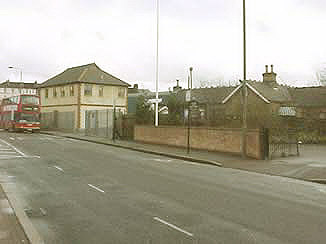 |
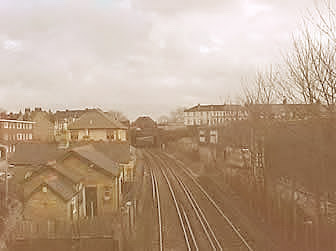 |
From: "Nick Catford" <nick@catford.fsbusiness.co.uk>
My Disused Stations web site also has a couple of pictures of this station and these are shown below together with some further monochrome pictures and historical information.
From: "Whperion" <whperion@lineone.net>
I am pleased that this information is on the web, and that many have commented.
With respect to the section of line Merton Abbey to Tooting, I am afraid I know very little, other than walking the trackbed as much as possible in my
slightly younger days. We would like to know the names of any coal merchants and if they had private owner trucks in their name at Tooting [Junction].
Also what was the name of the firm that ran the Coal Yard at Merton Abbey? I never made a note of it in the early 1970s.
The Merton Abbey Area had I believe more than one siding across Station Road and into the [New] Merton Board Mills Area - but when were they last used
and by what motive power and wagon types? One branch I believe served the "Crown Merton" [latterly Tube Investments] factory.
A little correction about Schools:
Pelham High School and Pelham Primary School Were [or are for Pelham Primary] in Southey Road, SW19.
Rutlish School, was built in Kingston Road, SW19. The buildings of the [all boys] school were condemned around 1956 and a new school built in Watery
Lane, SW20 on part of the John Innes Compost Making Site [we always said our school was built on .....].
The condemned buildings were then taken over by Surrey County Council education dept as Pelham County Girls School, until around 1966 when London
local government reorganisation brought in London Borough of Merton as Education Authority and 1970 the Borough adopted the three stage primary
middle [9-13yrs] and high school system. The girls school then became Pelham Middle School, The pre-fab type block in Rutlish Road backed onto the Merton
Abbey / Wimbledon - West Croydon line and during science woodwork or domestic science lessons the occasional noise, and sometimes sight of a BR
blue diesel hauling one or more grey mineral wagons and a brake van would interrupt lessons, the electric 2 coach service was fairly quite and I am
sure around 1972 on service towards Wimbledon one morning was a milk train [I believe this normally went around the line via Wimbledon Chase so I don't
think it was a scheduled service].
Later in 1973 the school buildings [main school] were finally demolished - the staff and pupils transferring to a new school in Lake Road/Arthur Road
Wimbledon known as Park House. The 'annex' remained as an annex of Merton Technical College - mostly for its [Musical] instrument repair and
construction courses. A few years ago the annex was demolished and overpriced housing built, coupled later with a refurbishment of Merton Park Station
Building into two residential dwellings and further new housing loosely over some of the trackbed from Merton Park towards Merton Abbey.
I do not ever recall seeing [from around 1969 when I spent more time near the line] freight workings to or from the Lines Bros Triang factory. I
suppose it all went by road by then.
From: "S Opacic" <opacic@chiplc.com>
I went to Fortescue School for one year in about 1964-65 and had to walk along Fortescue Road to get to the school on Courteney
Road from Merton Bridge over the railway line [I lived in Western Road then].
I am sure that on the right as you walked down Fortescue Road there were large railway sheds with the sliding [?] doors occasionally open showing a
railway engine that to me looked like it was from Stephenson's rocket days. Of course it was probably more recent but I have found no-one to confirm
this [I am sure it is not a false memory!]. I know about the railway line and the land to the right of these shed was I thought belonging to the Water
Board [there were two green open spaces as far as I remember] before the metal work factory on my way back to Western Road.
It might seem daft but I am so sad that these traces of the industrial Merton past are going and there are no memories.
Incidentally there are also no traces of old shop fronts which is another specialism in it's own right!
From: "Robert Catt" <bobcattegkk@googlemail.com>
What memories! I grew up at 99 Lyveden Road from 1945, with the goods yard in front, and the active line at the bottom of the garden.
The foot bridge was part of my play ground, as was [off limits] the goods yard.
Thank you for the really super pictures.
From: "Ian Semmons" <Ian Semmons@aol.com>
Fascinated to read about Tooting Junction Station and the Merton Abbey branch. I lived in Colliers Wood and eventually went to Rutlish.
The steam engine that used to work the daily freight train out of Merton Abbey used to pass the end of my road [Boundary Road] - I seem to recall that it
was a C2X number 32543 on most days. It used to go through in the morning and then return later in the evening. Having done its shunting it would often
sit with its train waiting the road out of the Merton Abbey branch. We got to know the train crew who often would let us up on the footplate and then
shunt back and forth. It obviously made an impression as I now drive trains on two heritage lines in Norfolk. I cannot recall the line ever being
connected - I used to go to the 70th London Boys Brigade who met in the church hall overlooking the line at Tooting Junction - we always knew it as that.
Good days - recently I went back to explore my old haunts which triggered some mixed emotions.
From: "Bob Barker" <RobertB@sunfield.org.uk>
Many thanks, a very interesting site with a lot of connections for me amongst all the contributions.
My Dad worked in the 1960's at the Crown Merton factory [subsequently became Corfield and Zigg?]. My Mum would take me on the bus to South Wimbledon, we'd walk
down Station Road to the factory and she'd go off over the bridge to one of her part time cleaning jobs in Mitcham for the evening.
I'd be left in my Dad's car for an hour or so till he came out to take us home, and in my memory I was facing a sort of marshalling yard?
Don't remember too much activity, but was sure I was looking at a rusty old steam train or two?
I've maybe got my bearings of this area a bit wrong, everything seemed to me to be facing the wrong way to me when I saw the Time Team episode on Abbey Mills.
My Mum worked for a while at the Tri-ang factory, and I can recall seeing the freight trains on the line there.
Following in the Rutlish tradition, I worked "the shut" at the Board Mills when I'd finished A levels in 1973. There were definitely rail tracks still
embedded then, I even vaguely think they may have extended out into the road somehow at the back?
Thanks to the contributor who gives 1970 as the date of the education changes. My 1966-1973 Rutlish cohort spanned the transition from Grammar School to
comprehensive. A couple of year groups were sent to us from Pelham Road as that school was closed, and I had never been quite sure whether this had
been in 1969 or 1970.
It was a disruptive time at the school. Mr Blenkinsop had died, I think in 1969, and Mr Coyle I believe had yet to be appointed. Despite all his posturing
in respect of discipline, "Hubie" Walker really did struggle to keep a handle on things.
From 1966-1968 I sat in the window seat of classes 2a and 3a in the John Innes building. It faced across the playing fields to the rail track between the houses.
One day, daydreaming during a lesson, I glanced out of the window to see a steam train travelling towards South Merton from Wimbledon Chase. Anybody got any
idea what it would have been doing on this line at this time?
I have a number of early memories of the trolleybuses. My Aunt lived in a flat above a shop on the corner by tooting Broadway underground station. As a toddler
I'd look out of the window and see the drivers having to reconnect the pole to the overheads where they'd come round the corner from the direction of Mitcham
towards Colliers Wood too fast. Guinness neon advert above the shops opposite, with a big clock and a moving toucan, very evocative of the 1950s.
Went with Nick Catford on one of my first "Red Rover" days out. You'd have been in your first year at Sutton Grammar Nick, I'd been at Ridge Road
with Richard Leech [and maybe Graham Clarke?]. Picked up my interest in buses and trains from you via Richard [did you ever have an old two pence-halfpenny
"ORD" bus ticket - if you did I think I came to own it via "swaps" with Richard].
On this particular trip you were determined to get a photo of a sliver, unpainted, "experimental" Routemaster that was plying a route somewhere
out Crystal Palace way. You having missed it at the first intended rendezvous, us little kids in tow had to spend the afternoon making do with our packed
lunches in the back seat of the bus for as you plotted a route to encounter the target bus coming in the opposite direction an hour or two later.
Things livened up a bit as the silver RM hove into sight and you lined up the camera ready for the shot - only for you to scream out as you pressed
the button that you'd run out of film!
I've had more exciting afternoons Nick. Couple of years later of course with the Radio Jackie stuff all the kids like me were desperate to lay claim to your
friendship as we tried to impress the girls!
I live in Cheltenham now and have no connections with the area, but get back now and then to watch AFC Wimbledon. A couple of times I've walked the back roads
of some of these old haunts, but, as another contributor says, with perhaps mixed feelings overall.